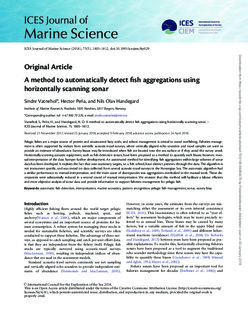A method to automatically detect fish aggregations using horizontally scanning sonar
Journal article, Peer reviewed
Published version

Åpne
Permanent lenke
http://hdl.handle.net/11250/2584609Utgivelsesdato
2018Metadata
Vis full innførselSamlinger
- Articles [3012]
- Publikasjoner fra CRIStin [3070]
Sammendrag
Pelagic fishes are a major source of protein and unsaturated fatty acids, and robust management is critical to avoid overfishing. Fisheries management is often supported by indices from scientific acoustic-trawl surveys, where vertically aligned echo sounders and trawl samples are used to provide an estimate of abundance. Survey biases may be introduced when fish are located near the sea surface or if they avoid the survey vessel. Horizontally scanning acoustic equipment, such as fish-detection sonars, have been proposed as a method to quantify such biases; however, manual interpretation of the data hamper further development. An automated method for identifying fish aggregations within large volumes of sonar data has been developed. It exploits the fact that near-stationary targets, i.e. a fish school, have distinct patterns through the data. The algorithm is not instrument specific, and was tested on data collected from several acoustic-trawl surveys in the Norwegian Sea. The automatic algorithm had a similar performance to manual interpretation, and the main cause of discrepancies was aggregations overlooked in the manual work. These discrepancies were substantially reduced in a second round of manual interpretation. We envision that this method will facilitate a labour efficient and more objective analysis of sonar data and provide information to support fisheries management for pelagic fish.